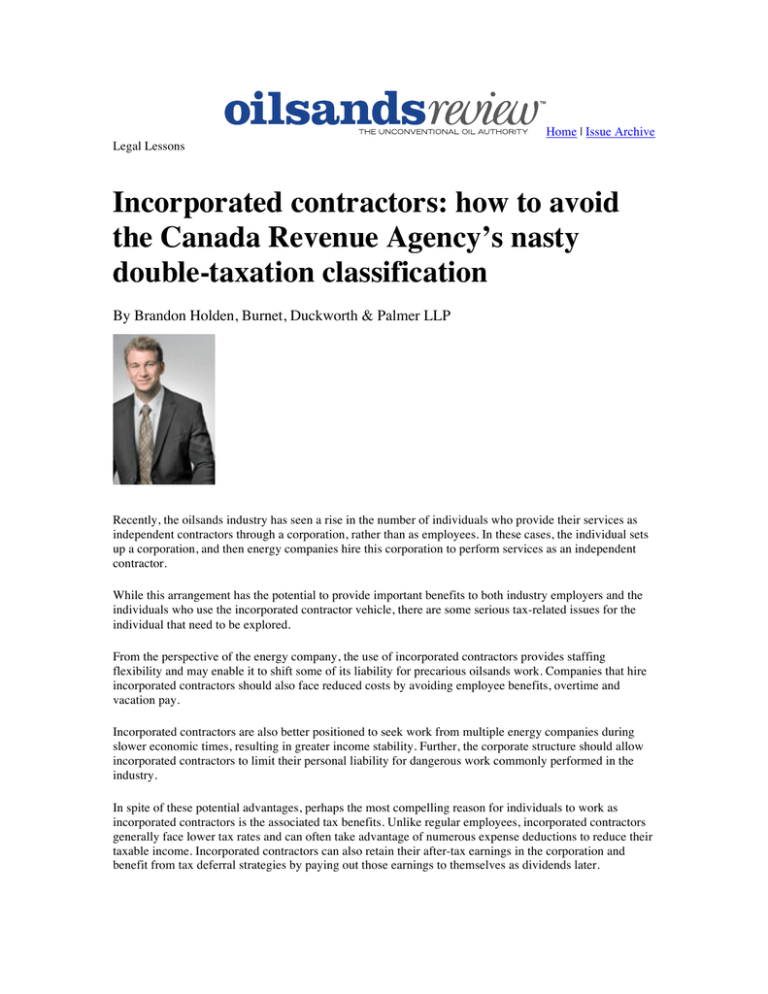
Home | Issue Archive
Legal Lessons
Incorporated contractors: how to avoid
the Canada Revenue Agency’s nasty
double-taxation classification
By Brandon Holden, Burnet, Duckworth & Palmer LLP
Recently, the oilsands industry has seen a rise in the number of individuals who provide their services as
independent contractors through a corporation, rather than as employees. In these cases, the individual sets
up a corporation, and then energy companies hire this corporation to perform services as an independent
contractor.
While this arrangement has the potential to provide important benefits to both industry employers and the
individuals who use the incorporated contractor vehicle, there are some serious tax-related issues for the
individual that need to be explored.
From the perspective of the energy company, the use of incorporated contractors provides staffing
flexibility and may enable it to shift some of its liability for precarious oilsands work. Companies that hire
incorporated contractors should also face reduced costs by avoiding employee benefits, overtime and
vacation pay.
Incorporated contractors are also better positioned to seek work from multiple energy companies during
slower economic times, resulting in greater income stability. Further, the corporate structure should allow
incorporated contractors to limit their personal liability for dangerous work commonly performed in the
industry.
In spite of these potential advantages, perhaps the most compelling reason for individuals to work as
incorporated contractors is the associated tax benefits. Unlike regular employees, incorporated contractors
generally face lower tax rates and can often take advantage of numerous expense deductions to reduce their
taxable income. Incorporated contractors can also retain their after-tax earnings in the corporation and
benefit from tax deferral strategies by paying out those earnings to themselves as dividends later.
The Canada Revenue Agency increases its scrutiny of incorporated contractors
The Canada Revenue Agency (CRA) is well aware of the growth of incorporated contractors, and has been
increasing its scrutiny of the practice in an attempt to reclassify these contractors, where appropriate, as
personal services businesses (PSBs).
Under the federal Income Tax Act, a PSB is defined as a corporation whose shareholder (owning 10 per
cent or more of the shares) “would reasonably be regarded as an employee” of the companies he works for
in the absence of a corporate structure. This definition contains two exceptions: corporations staffing more
than five full-time employees throughout the year and corporations providing services to, and receiving
payment from, an affiliated corporation.
Overall, PSBs commonly involve individuals who consider themselves incorporated contractors, but who
act just like ordinary employees.... In other words, if it looks like a duck, and quacks like a duck, it is
probably a duck.
The negative consequences of recent tax changes
Being classified by the CRA as a PSB rather than an incorporated contractor has significant negative tax
consequences. As PSBs, incorporated individuals lose many of the tax benefits available to other
corporations. For example, a PSB does not receive the small business deduction, which allows Canadiancontrolled corporations to greatly reduce some or all of their taxable income by a fixed percentage.
Moreover, PSBs cannot deduct many of their ordinary business expenses that would otherwise further
reduce their taxable income. Limited exceptions to this latter rule include employee salaries and benefits,
expenses for contract negotiation and property sales, and certain legal costs, all of which remain deductible.
Importantly, the negative tax consequences of being classified as a PSB have become more severe with
recent amendments to the Income Tax Act.
Prior to the recent amendments, PSBs were eligible for a general tax rate reduction of 13 per cent. This
lowered the federal corporate tax rate PSBs paid from 28 per cent to 15 per cent. For tax years beginning
after Oct. 31, 2011, however, PSBs lost this 13 per cent differential. They now face the full 28 per cent
federal corporate tax rate on their eligible income, in addition to the applicable provincial corporate tax rate
(in Alberta, 10 per cent).
The practical effect of these amendments is to virtually eliminate any tax deferral benefits that PSBs still
had. As a result, a PSB in Alberta now pays a combined federal and provincial corporate tax rate of 38 per
cent on eligible income.
And, when that after-tax income is later paid out as dividends of the corporation, the individual owning the
corporations must pay additional income tax on those amounts, which starts at a rate of 15 per cent,
provided the individual has income in excess of the personal exemption amount. This means that
incorporated individuals deemed to be PSBs are subject to double taxation.
Compared to the double taxation imposed on PSBs, an individual in the highest bracket in Alberta pays a
maximum of 39 per cent in combined federal and provincial income tax on eligible earnings. In many
cases, an incorporated individual would therefore pay significantly less tax overall by simply becoming an
employee and taking all of the corporation’s income as salary taxed at the highest marginal rate.
Avoiding the nasty PSB classification
Since the defining quality of PSBs is the incorporated individual’s resemblance to an employee, the best
line of defense against the CRA’s harsh tax treatment of PSBs is for individuals claiming to be incorporated
contractors to ensure they act like independent contractors rather than employees of the companies they
work for.
The differences between employees and an independent contractor can often be difficult to discern, but the
CRA has adopted some guidelines from case law experience in Canadian courts. The Supreme Court of
Canada, for example, has stated that the central question is whether an individual is providing services “as a
person in business on his own account.” Several key factors help answer this question, including whether
the individual:
•
•
•
•
•
Is subject to the employer’s control;
Provides his own equipment;
Hires his own helpers and manages them;
Assumes financial risk; and
Has the opportunity to profit in the performance of his tasks.
Additionally, the Federal Court of Appeal has ruled that the subjective intentions of the parties (such as
how they refer to their relationship orally or in the terms of a contract) may also be relevant to the type of
relationship that exists between an individual and his employer, but these intentions cannot trump the
objective factors mentioned above.
Looking at how the most-relevant factors are typically applied, an independent contractor likely sets his
own schedule and supervises his own work. An independent contractor also normally owns most of his
equipment, such as a vehicle or tools. If additional helpers are required, an independent contractor typically
hires them and oversees their work himself. And as a result of these responsibilities, an independent
contractor tends to bear the risks of a project running past its deadline or over its budget, and similarly
stands to profit if a job is completed early or under budget.
Conversely, an employee tends to be someone whom the employer supervises closely by setting required
days and times of work and monitoring job performance. In an employer-employee relationship, the
employer also normally provides the employee’s tools and equipment and hires other helpers, if required.
Finally, an employee is not likely to bear financial risks associated with his work, nor does he stand to
profit greatly beyond his wage or salary in the normal performance of his tasks.
Although none of these individual factors is determinative, the more an incorporated contractor organizes
his corporation’s business relationship with his employer to resemble that of an independent contractor, the
less likely the CRA will assess the individual as an “incorporated employee” carrying on a PSB.
Similarly, it is also helpful to take simple steps such as obtaining separate insurance, using letterhead with
the corporation’s name on it and not working full-time hours for one employer exclusively.
Other measures
Individuals who mistakenly consider themselves as incorporated contractors, but who actually more
resemble employees, may wish to reconsider their corporate structure. Depending on their allowable
deductions and personal income tax bracket, they may still obtain a slight tax deferral advantage as a PSB.
If, however, an incorporated individual faces considerably higher tax from being classified as a PSB,
alternative strategies such as paying out all corporate earnings as salary or even dissolving the corporation
and working as an employee may be better options for tax purposes.
Individuals purporting to operate as incorporated contractors, or who are considering establishing a
corporate vehicle for such purposes, would be well advised to seek some expert tax guidance on the subject
to mitigate the possible adverse consequences of the recent amendments to the tax legislation.
Brandon Holden is an associate at Burnet, Duckworth & Palmer who practices in the areas of securities
and tax law.
Copyright JuneWarren-Nickle’s Energy Group. All rights reserved.
Disclaimer | Privacy Policy | Comments




